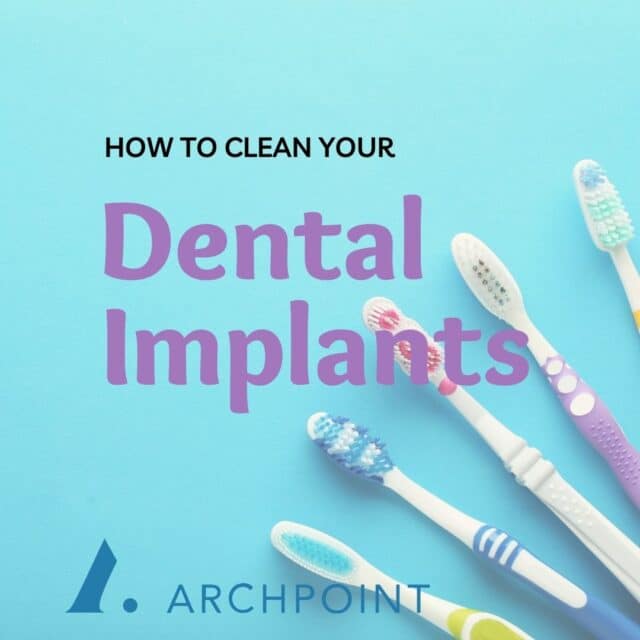Did you just replace all of your teeth with dental implants? Maybe you have a combination of both natural teeth and implants in your mouth? Knowing the right way how to clean your dental implants will help you enjoy healthier gums, fresher breath, and most importantly—get the most out of your investment.
A Note About Implant-Related Gum Disease
First and foremost, the most important thing you need to know about keeping dental implants clean is that the gums around them need to stay healthy. The biggest risk to dental implants is peri-implantitis, which is the implant form of gum disease. When the gums and bone around an implant become infected, it destroys the attachment tissues that hold your implant in place. In other words, the implant can become loose or fall out.
Bottom line, you want to keep your gums as healthy and clean as possible.
How to Brush Your Dental Implants
Dental implants may not be able to develop cavities, but it’s still possible for tartar buildup and stain to accumulate on their surface. Plan to brush them for at least two minutes, twice a day. Make sure you’re using a non-abrasive toothpaste and soft or extra-soft toothbrush, as harsh products could be too rough on your gums and restorations.
Gently brush your implant restorations the same way you do your other teeth and then brush along the gumlines where plaque tends to be heaviest.
How to Clean Your Dental Implants with Floss
Flossing around a dental implant is nearly identical to flossing an anatomical tooth. You want to wrap the floss in a “C” shape against the side of the implant, then rub it up and down a few times to thoroughly clean the side. Lift the floss up and over your gums, then move to the next tooth or implant.
Water flossing is a great alternative to traditional flossing. Water flossers use a steady stream of water that can reach around implants, between teeth, and under gumlines where flossing cannot reach. Simply trace the water flosser around each implant and tooth to clean the areas immediately next to the gums. Pause between each of your teeth to flush those spaces as well.
Adjusting to a water flosser can take a bit of time (it’s messy and can feel ticklish at first) but with practice, it’s preferred over traditional flossing. Especially for people with dental implants. Investing in a quality water flosser—one where you can adjust the pressure—is a great way to ensure your implants last as long as possible.
The biggest key to having a water flosser or flossing around dental implants? Using it at least once a day. Your toothbrush won’t clean those areas, so you have to physically clean it with floss on a daily basis to keep your smile healthy.
How to Clean Your Dental Implants (Underneath a Multi-Tooth Prosthesis)
Any time you’re getting an implant-supported bridge or a hybrid appliance like All-on-4 implants, there will be a space between your prosthesis and your gum tissues underneath. Knowing how to clean it effectively will prevent that space from becoming a food trap or getting infected.
There are a few different ways you can clean this area and it’s really up to your personal preferences, as well as how wide that particular space is.
First, you have what’s called “super floss”. It’s like regular floss but stiff on one end, then it tufts out into a thicker strand of yarn-like material. You simply glide the super floss underneath your bridge, then wipe back and forth underneath. Then, wrap the floss around the implant on each side of that space to clean more closely along the gumlines.
Second, you have traditional floss and a floss threader. You use the floss threader to weave the strand underneath, then clean the area as you would with the super floss. Except in this case, the floss is much thinner.
Third, there’s the option of using a tufted proxy brush. These tapered, miniature brushes come in different sizes and shapes, making it easy to brush underneath fixed prosthetics or other various spaces throughout your mouth.
And finally, there are water flossers. Water flossing is preferred, as it’s both effective and capable of reaching practically anywhere in your mouth.
Cleaning Removable Overdentures (Snap-on Dentures)
Snap-on dentures need to be cleaned after you eat and removed each night. Don’t sleep in them, because they can harbor bacteria or food debris up underneath your denture, leading to an infection. The same goes for not rinsing your prosthesis after meals, since it can turn into a food trap where particles seep up underneath your plate.
Rinse your dentures regularly throughout the day, always after meals, then put them back in your mouth. But in the evenings make sure you’re also thoroughly brushing your dentures to remove any plaque that is trying to settle onto them. If you have time to brush them at additional times in the day, even better.
At least a few times a week, make sure you’re soaking your denture in an effervescent cleanser to loosen additional buildup or stain. Then brush it thoroughly the next morning and rinse it well before you put it back into your mouth.
And finally, make sure you’re cleaning the inside of your mouth after you take out your denture. You can use a soft washcloth to wipe your gums or an extra-soft toothbrush with tap water. If you like, you can also use a non-abrasive toothpaste to clean the implant abutments in your mouth.
Do You Still Need to Schedule Dental Cleanings?
Yes! Your dentist and hygienist will have special tools designed precisely for cleaning around dental implants. Plan to keep your normal six-month checkup appointment. Aside from cleaning your teeth or implants, your dentist still needs to do things like screen for oral cancer and measure your bone levels.
Need a Professional Opinion?
ARCHPOINT offers comprehensive dental implant options in Fort Worth and Dallas. If you’re considering implants, All-on-4, or snap-on dentures, give our office a call today.








